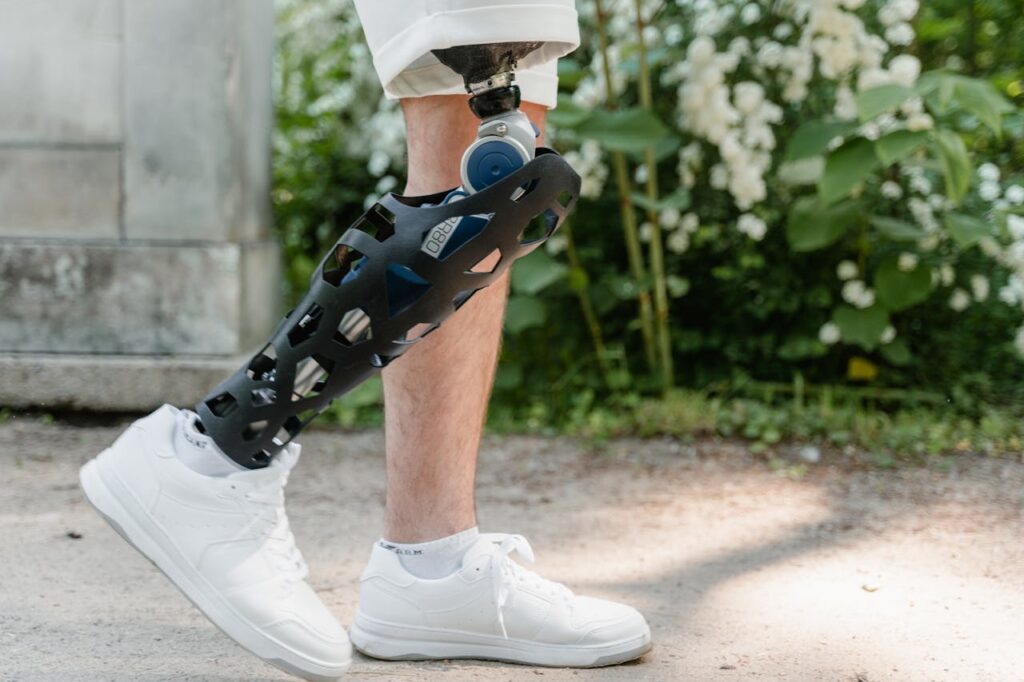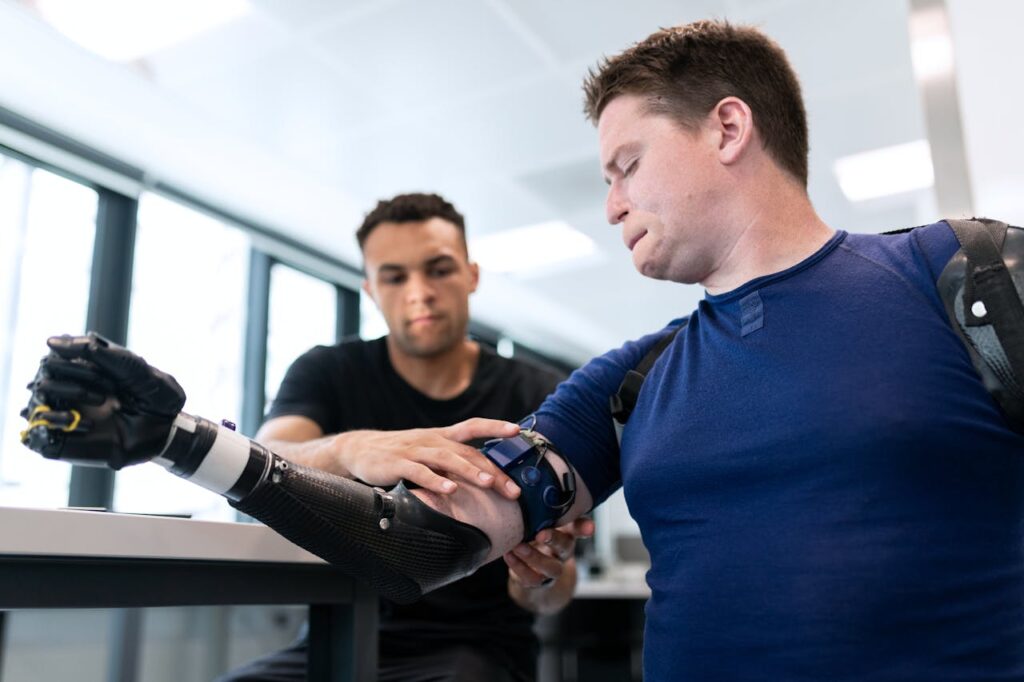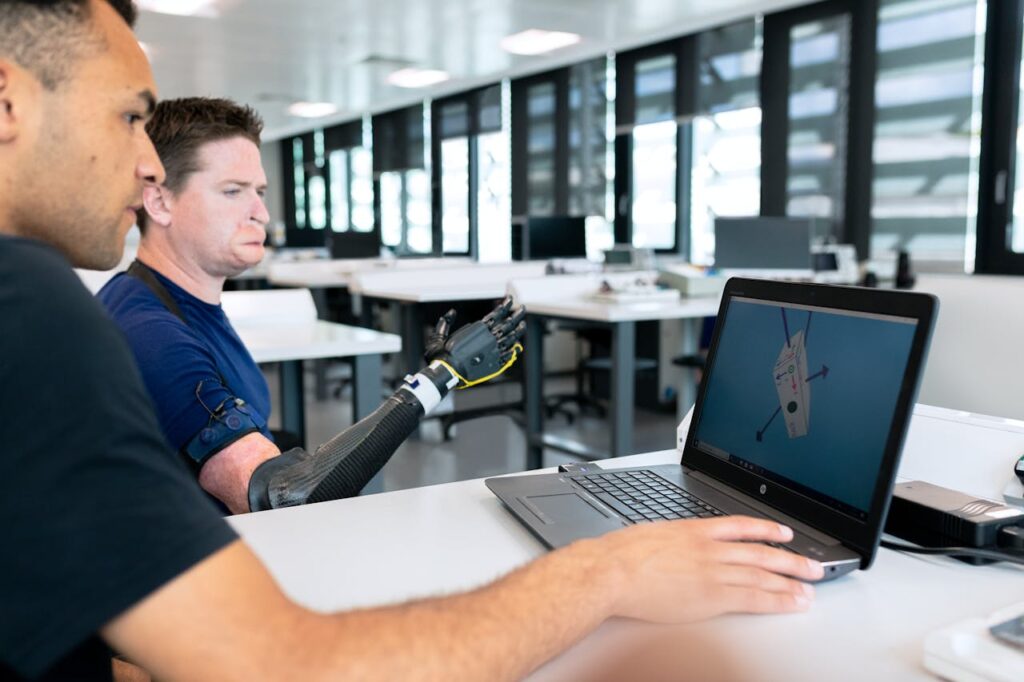Bionic prosthetics have transformed lives, offering advanced functionality, seamless integration with the human body, and a level of mobility that was once unimaginable. However, with the rise of smart prosthetics—devices equipped with sensors, connectivity, and artificial intelligence—a new challenge has emerged: cybersecurity.
Much like smartphones or smart home devices, bionic limbs that rely on digital technology are vulnerable to cyber threats. From data breaches to malicious hacking, the risks associated with connected prosthetics are real and potentially harmful.
The Rise of Smart Prosthetics and Their Vulnerabilities
Smart prosthetics represent a significant leap forward in assistive technology. These devices are equipped with advanced features such as myoelectric controls, machine learning, and Bluetooth connectivity, enabling users to perform complex tasks with precision and ease. However, the same features that make these prosthetics revolutionary also expose them to cyber risks.
How Smart Prosthetics Work
Smart prosthetics rely on a combination of hardware and software to function. Sensors embedded in the prosthetic detect electrical signals from the user’s muscles or nerves, translating them into commands that control movement.
Connectivity features, such as Bluetooth or Wi-Fi, allow the device to sync with companion apps, enabling users to customize settings, monitor performance, and receive software updates.
While these technologies enhance functionality, they also create entry points for cyberattacks. For instance, an unsecured Bluetooth connection could allow unauthorized access to the device, while outdated software might leave it vulnerable to malware.
Potential Risks
The consequences of a cyberattack on a smart prosthetic can range from inconvenience to serious harm. Unauthorized access to the device could disrupt its functionality, causing erratic movements or rendering it inoperable.
In more severe cases, cybercriminals could exploit the device to collect sensitive data, such as the user’s health information or location.
For businesses, addressing these vulnerabilities is not just a technical challenge—it’s a responsibility. Users trust that their prosthetics are safe and reliable, and any breach of that trust could have significant implications for both the user and the company.

Why Cybersecurity Matters in Prosthetics
The integration of digital technology into prosthetics has blurred the line between the physical and digital worlds. As these devices become more connected, the need for robust cybersecurity measures becomes increasingly important.
Protecting User Privacy
Smart prosthetics often collect and transmit sensitive data, including health metrics, movement patterns, and usage habits. Without proper safeguards, this data could be intercepted or stolen, putting the user’s privacy at risk.
For example, a hacker could access location data to track a user’s movements, or exploit health information for identity theft.
Manufacturers must prioritize data encryption and secure communication protocols to protect user privacy. By ensuring that data is stored and transmitted securely, companies can minimize the risk of breaches and build trust with their users.
Ensuring Device Reliability
For users, the reliability of their prosthetic is non-negotiable. A cyberattack that disrupts functionality could have immediate and serious consequences, particularly for individuals who rely on their prosthetics for daily activities or safety.
For instance, a compromised prosthetic leg could malfunction while the user is walking, leading to a fall or injury.
Similarly, a hacked prosthetic arm could lose its grip on an object, causing accidents or damage. Ensuring that devices are resilient to cyber threats is essential for maintaining user confidence and safety.
Addressing Ethical Considerations
As prosthetics become more integrated with the human body, the ethical implications of cybersecurity take on greater significance. Users must feel confident that their devices are not only functional but also secure from external interference.
For businesses, this means adopting a proactive approach to cybersecurity, incorporating best practices into every stage of the product lifecycle.
Transparent communication about security measures and ongoing updates demonstrates a commitment to user safety and ethical responsibility.

How Cyberattacks on Prosthetics Can Happen
Understanding the mechanisms through which prosthetics can be compromised is crucial for developing effective defenses. Cyberattacks on prosthetic devices often exploit vulnerabilities in hardware, software, and communication channels.
Exploiting Communication Channels
Many smart prosthetics rely on Bluetooth, Wi-Fi, or other wireless technologies for connectivity. While these features enable convenient interactions with companion apps and other devices, they can also become points of vulnerability.
For example, an attacker could intercept an unsecured Bluetooth connection, gaining unauthorized access to the device. Once connected, they could manipulate the prosthetic’s settings, disrupt its functionality, or even lock the user out entirely.
Securing these communication channels is essential. Businesses must implement encryption protocols that prevent unauthorized access and ensure that connections are secure before data is exchanged.
Encouraging users to enable security features, such as two-factor authentication or password protection, further reduces risk.
Targeting Software Weaknesses
Outdated or poorly designed software can create opportunities for cyberattacks. If a prosthetic’s firmware is not regularly updated, it may contain vulnerabilities that hackers can exploit. Similarly, apps that lack secure coding practices could expose users to malware or phishing attempts.
For manufacturers, adopting a proactive approach to software security is critical. Regular updates that address known vulnerabilities, rigorous testing before deployment, and swift responses to emerging threats are key strategies for maintaining device integrity.
Malware and Ransomware Threats
As prosthetics become increasingly connected, they are not immune to the broader threats facing the Internet of Things (IoT) ecosystem. Malware and ransomware attacks, which have historically targeted computers and smartphones, can now affect smart prosthetics.
In a ransomware scenario, an attacker could lock the prosthetic’s functionality and demand payment for its release. Such an incident not only disrupts the user’s daily life but also raises significant ethical and legal concerns.
Businesses can mitigate these risks by adopting robust cybersecurity frameworks, conducting regular audits, and educating users about recognizing and avoiding potential threats.

Strategies for Enhancing Cybersecurity in Prosthetics
Addressing cybersecurity in prosthetics requires a multi-faceted approach that involves manufacturers, users, and policymakers. By implementing comprehensive security measures, companies can protect their devices while building trust and confidence among their users.
Embedding Security in the Design Process
Cybersecurity should not be an afterthought—it must be integrated into every stage of the design and development process. This includes choosing secure hardware components, implementing encrypted communication protocols, and designing software with minimal attack surfaces.
For example, manufacturers can include tamper-resistant chips that prevent unauthorized modifications to the device’s firmware. Similarly, designing apps with secure coding practices and encryption ensures that data is protected both in transit and at rest.
By embedding security into the foundation of their products, businesses can reduce the likelihood of vulnerabilities and create a more resilient user experience.
Partnering with Cybersecurity Experts
Given the complexity of cybersecurity, partnering with experts in the field can provide valuable insights and solutions. Cybersecurity professionals can conduct penetration testing to identify weaknesses, develop custom security solutions, and provide ongoing monitoring for potential threats.
Collaborations with cybersecurity firms also demonstrate a commitment to user safety, enhancing the company’s reputation and fostering trust. For businesses, these partnerships are an investment in long-term success and risk mitigation.
Educating Users on Cybersecurity Best Practices
While manufacturers play a critical role in ensuring device security, users also have a responsibility to protect their prosthetics. Educating users about cybersecurity best practices empowers them to recognize and mitigate risks.
Promoting Safe Usage Habits
Users should be encouraged to follow simple but effective security practices, such as:
- Keeping firmware and companion apps up to date to benefit from the latest security patches.
- Avoiding public or unsecured Wi-Fi networks when using connected features.
- Monitoring for unusual device behavior and reporting any suspected issues to the manufacturer.
Manufacturers can provide resources such as user guides, tutorials, and workshops to educate users about these habits. Clear communication about the importance of cybersecurity ensures that users feel informed and supported.
Addressing Cybersecurity Challenges for Businesses
For manufacturers of smart prosthetics, cybersecurity is not just a technical requirement—it’s a cornerstone of trust and reputation. Addressing cybersecurity challenges proactively can position businesses as leaders in innovation while ensuring the safety and satisfaction of their users.
Implementing a Continuous Monitoring Framework
The cyber threat landscape is constantly evolving, and static security measures are no longer sufficient. Businesses must adopt a continuous monitoring framework that actively scans for vulnerabilities, unusual activity, or potential breaches.
This approach involves deploying automated tools to detect anomalies in device behavior, as well as regular software updates to patch any vulnerabilities. By providing ongoing monitoring and maintenance, manufacturers can ensure their devices remain secure against emerging threats.
For users, this translates into peace of mind, knowing their prosthetics are protected in real time. Communicating these efforts through transparent policies and user notifications reinforces trust in the brand and its commitment to safety.
Encouraging a Culture of Cybersecurity
Within the organization, fostering a culture of cybersecurity is essential for staying ahead of threats. Employees across all departments—from R&D to customer support—should be trained to understand the importance of security and their role in maintaining it.
For instance, development teams should prioritize secure coding practices, while customer service teams should be equipped to handle reports of suspicious activity. Creating a cross-functional task force dedicated to cybersecurity ensures that it remains a top priority throughout the company.
For businesses, engaging users as part of this culture is equally important. Offering feedback channels where users can report security concerns or suggest improvements creates a collaborative environment and demonstrates a user-first approach to security.

Collaborating with Policymakers and Industry Leaders
Cybersecurity in prosthetics is a shared responsibility that extends beyond individual manufacturers. By collaborating with policymakers, industry leaders, and standards organizations, businesses can contribute to the development of best practices and regulations that protect users.
Establishing Industry Standards
Currently, the cybersecurity landscape for prosthetics lacks comprehensive industry-wide standards. Manufacturers have the opportunity to work with regulatory bodies and professional organizations to establish guidelines for secure design, testing, and operation.
For example, creating a standardized protocol for encrypted communication between devices and apps could prevent inconsistencies that lead to vulnerabilities. Similarly, defining baseline security requirements for smart prosthetics ensures that all manufacturers adhere to a minimum standard of protection.
Being actively involved in these initiatives allows businesses to shape the regulatory environment while demonstrating their leadership and commitment to user safety.
Advocating for Cybersecurity Awareness
In addition to setting standards, businesses can collaborate with advocacy groups and educational institutions to raise awareness about cybersecurity in prosthetics.
Hosting workshops, webinars, or public campaigns helps inform both users and the broader community about the importance of securing these advanced devices.
For example, a webinar featuring cybersecurity experts and prosthetic users could explore common threats and practical solutions, empowering attendees with actionable knowledge.
Such initiatives not only benefit users but also position the company as a thought leader in the field.
Preparing for the Future of Smart Prosthetics
As smart prosthetics continue to evolve, their integration with advanced technologies such as artificial intelligence, neural interfaces, and cloud-based systems will create new opportunities and challenges for cybersecurity. Businesses must anticipate these trends and adapt their strategies to remain effective.
Integrating AI for Threat Detection
Artificial intelligence (AI) has the potential to revolutionize cybersecurity by enabling devices to detect and respond to threats autonomously. For smart prosthetics, this means embedding AI algorithms that analyze data in real time to identify unusual patterns or potential breaches.
For example, a prosthetic arm could use AI to detect unauthorized commands or unexpected activity, automatically locking its functionality until the issue is resolved. This proactive approach minimizes the impact of cyberattacks and enhances user safety.
Businesses that invest in AI-driven security solutions can differentiate their products as cutting-edge and highly reliable, appealing to tech-savvy users who prioritize both functionality and protection.
Exploring Blockchain for Data Security
Blockchain technology offers a promising solution for securing data generated by smart prosthetics. By creating an immutable record of transactions and interactions, blockchain ensures that data cannot be tampered with or accessed without proper authorization.
For instance, a blockchain-based system could securely log firmware updates, user activity, and data exchanges between the prosthetic and its companion app. This transparency not only strengthens security but also fosters user trust by providing a clear record of device interactions.
For businesses, adopting blockchain represents a forward-looking approach to cybersecurity that aligns with the growing emphasis on data integrity and accountability.

Future-Proofing Cybersecurity in Prosthetics
As the integration of technology and prosthetics becomes more advanced, the need to future-proof cybersecurity strategies becomes paramount. Businesses must look beyond current threats and prepare for the next wave of challenges and opportunities. Proactively addressing these issues ensures that devices remain secure, reliable, and trusted for years to come.
Adapting to Neural Interface Technologies
One of the most promising developments in smart prosthetics is the integration of neural interfaces, which connect directly to the user’s nervous system.
These interfaces enable seamless communication between the brain and the prosthetic, allowing for intuitive control and even sensory feedback. However, they also introduce new cybersecurity risks.
A compromised neural interface could have severe implications, from disrupting the functionality of the prosthetic to interfering with the user’s neurological signals.
To address these risks, businesses must adopt rigorous security protocols, including encrypted data transmission, real-time monitoring, and fail-safe mechanisms that prevent unauthorized control of the device.
Collaborating with neuroscientists, cybersecurity experts, and regulatory bodies is essential to developing safe and secure neural interface technologies. For users, clear communication about the steps taken to protect these advanced systems fosters confidence in the technology.
Safeguarding Cloud-Based Systems
Many modern prosthetics leverage cloud-based systems for data storage, analytics, and remote updates. While these systems enhance functionality and user convenience, they also present a potential attack vector for cybercriminals.
Businesses must prioritize securing their cloud infrastructure by implementing multi-layered defenses, such as firewalls, intrusion detection systems, and regular audits. Encrypting data both at rest and in transit ensures that sensitive information remains protected, even in the event of a breach.
In addition, offering users transparency about how their data is collected, stored, and used builds trust. Providing options for users to control their data, such as opting out of non-essential data sharing, aligns with global privacy standards and reinforces the company’s commitment to ethical practices.
Building Trust Through Transparency
Cybersecurity is as much about trust as it is about technology. For users, knowing that their prosthetic is safe and secure is a fundamental requirement. Businesses can strengthen this trust by adopting a transparent approach to cybersecurity.
Communicating Security Efforts
Users are more likely to trust a company that openly communicates its security measures. This includes sharing information about the technologies and protocols used to protect devices, as well as updates on new developments and improvements.
For example, a manufacturer might release regular security updates through newsletters or social media, detailing how these updates address specific vulnerabilities. Providing a dedicated support channel for cybersecurity-related inquiries ensures that users feel heard and supported.
Transparency also extends to incident management. In the rare event of a cybersecurity breach, businesses must respond quickly and transparently, notifying affected users and outlining the steps being taken to resolve the issue.
This proactive approach demonstrates accountability and a commitment to user safety.
Empowering Users Through Education
Education is a powerful tool for reducing cybersecurity risks. By equipping users with the knowledge and skills they need to protect their devices, businesses can foster a sense of empowerment and responsibility.
Providing accessible resources, such as video tutorials, FAQs, and webinars, ensures that users understand the importance of cybersecurity and how to implement best practices. Topics might include securing Bluetooth connections, recognizing phishing attempts, and safely updating firmware.
Businesses can also collaborate with advocacy groups and community organizations to reach a broader audience, ensuring that cybersecurity education is inclusive and widely accessible.
A Secure Future for Prosthetics
The integration of cybersecurity into prosthetic design and operation is not just a technical challenge—it’s a moral imperative. Smart prosthetics represent a fusion of technology and humanity, and protecting these devices means safeguarding the lives and identities of their users.
Anticipating Emerging Threats
The rapid advancement of technology means that the cyber threat landscape is constantly evolving. Businesses in the prosthetics industry must adopt a forward-thinking mindset, anticipating future vulnerabilities and proactively developing solutions.
For example, as neural interfaces become more common, the potential for external interference with these connections will increase.
A compromised neural interface could have profound consequences, from disrupting prosthetic functionality to affecting the user’s nervous system.
Businesses must invest in advanced encryption protocols, tamper-proof hardware, and real-time threat detection systems to address these challenges.

Creating a Collaborative Ecosystem
The security of prosthetics cannot rest solely on individual manufacturers. A secure future depends on creating an ecosystem where businesses, regulators, and researchers work together to establish standards and share knowledge.
For instance, developing industry-wide frameworks for secure data exchange between devices and companion apps ensures consistency and reduces vulnerabilities.
Similarly, collaboration with government agencies can lead to the creation of certifications or compliance standards that validate the security of prosthetic devices.
Designing with Privacy as a Priority
Privacy is a cornerstone of cybersecurity, particularly for devices that collect and transmit sensitive user data. As prosthetics become more advanced, the amount and complexity of data they handle will increase. This includes movement patterns, health metrics, and even neural signals.
Businesses must prioritize privacy in their designs, implementing features that give users control over their data.
For example, offering granular permissions for data sharing and anonymizing user information for analytics ensures that personal details are protected. Transparency about how data is stored, used, and shared further strengthens trust.
Leveraging Artificial Intelligence for Proactive Defense
Artificial intelligence (AI) holds immense potential for enhancing cybersecurity in prosthetics. AI-driven systems can analyze large volumes of data in real time, identifying patterns and anomalies that indicate potential threats.
For example, a prosthetic with integrated AI could detect unusual commands or unauthorized access attempts and take immediate action to mitigate the risk.
AI can also play a role in predictive security, where algorithms identify vulnerabilities before they are exploited. This allows businesses to address issues preemptively, reducing the likelihood of breaches.
Conclusion
Cybersecurity in prosthetics is not just a technical consideration—it is a fundamental requirement for ensuring user safety, privacy, and trust. As smart prosthetics become increasingly advanced and integrated into daily life, the potential risks associated with connectivity and digital features must be met with robust security measures.
For users, the promise of smart prosthetics lies in their ability to restore and enhance mobility, independence, and confidence. For businesses, it is an opportunity to innovate and lead by creating devices that are both secure and user-centric.
By embedding cybersecurity into every stage of product design, collaborating with experts, and fostering transparency, manufacturers can build trust and set a new benchmark for safety and reliability.
As we look to the future, the integration of technologies like neural interfaces and AI will open up incredible possibilities in prosthetics, but they will also bring new challenges. Staying ahead of these challenges requires vigilance, creativity, and a commitment to prioritizing user well-being.



